[ Honda Civic Type R Mugen ]
Few mid-2000s Japanese hot hatches wield as much enthusiast power as the Honda Civic Type R. But if that’s not fierce enough, say ‘konnichiwa’ to the violently boisterous Civic Type R Mugen
Words NATHAN CHADWICK & RICHARD GOODING Photography CHRIS FROSIN
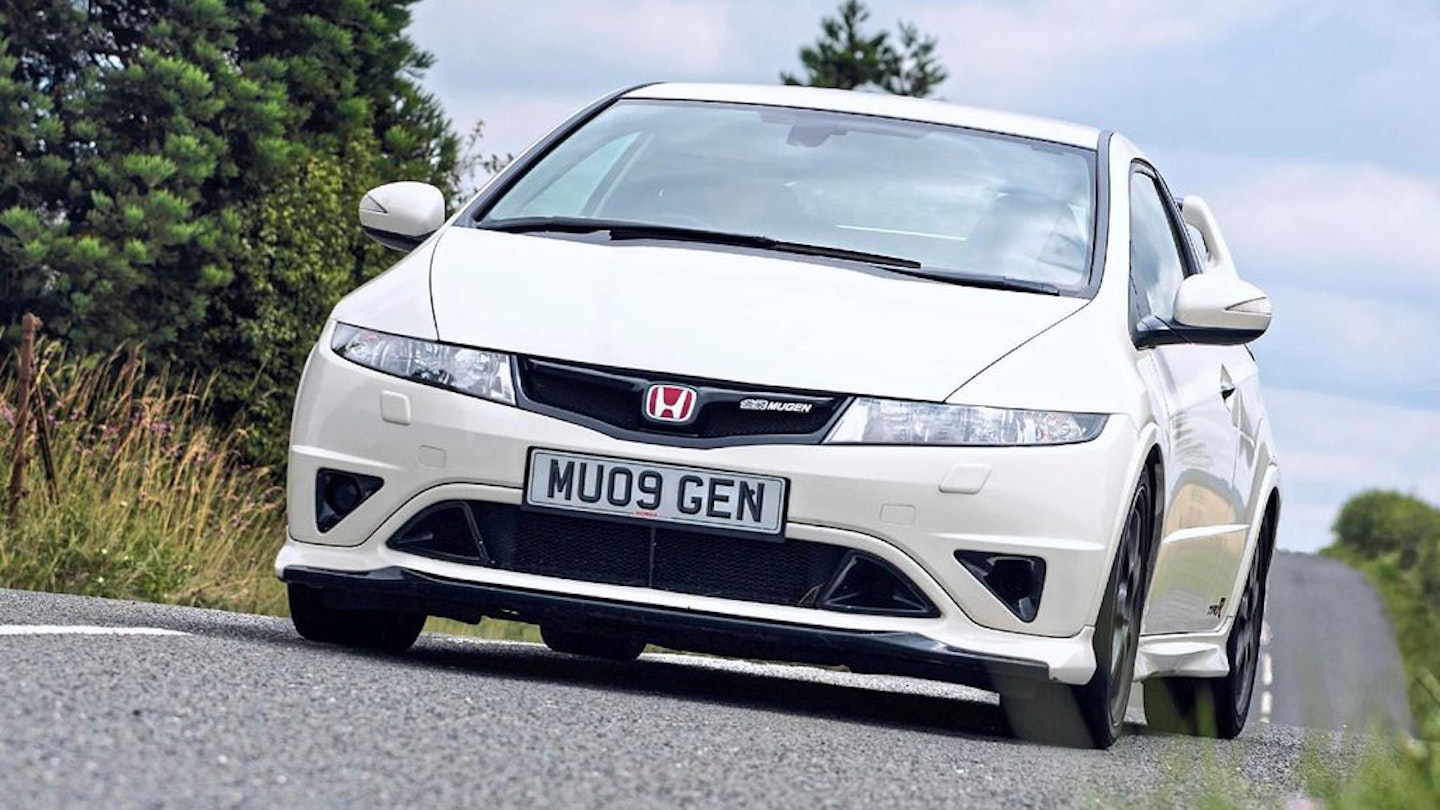
You’d be forgiven for walking past the Honda Civic Type R Mugen if you saw it parked up. To the uninitiated, it looks like another modified Japanese car – enormous spoilers and splitters, and a ride height low enough to make ants duck.
It doesn’t feel too special when you get inside either. Sure, there’s an extra bank of dials on the top of the dashboard – yours for an extra £1000 when new – showing oil and water temperature, and a pair of figure-hugging Recaro seats. The hottest of Civic Type Rs still has a radio too.
Not that it’s much use when I press the start button. The Mugen whumps into life angrily and idles with a menacing serrated air. It’s certainly not musical in the traditional sense. Inhale deeply, everybody.

No turbos here; just high-revving natural aspiration

Rear wing aids aero and downforce

Recaro chairs and rear-seat delete part of Track Pack
It’s already got the pulse up like Nineties techno music, but of course many noisy, modified four-cylinders have flattered to deceive – contemporary tuning bible Max Power has a lot to answer for. And trickling along A and B-roads to reach our test location, that does seem to be the case here.
The Mugen exhibits the typical FN2-generation Honda Civic Type R complaint – a lack of immediate torque – but I know from driving the standard car that I must work for it. What’s more worrying is that for all its extra power – it has 237bhp compared to the 198bhp of the standard Type R – and angrily rasping exhaust note, it still doesn’t feel quick, despite the speedometer trying its hardest to convince me otherwise.
Pushing a little harder, the engine sounds snarly, shy of the VTEC – Valve Timing Electronically Controlled as Honda refers to it, but actually variable valve timing & lift electronic control – zone. All the excitement begins just after 6000rpm. Unlike the standard car, the Mugen wants you to know it’s enabled the higher cam lobes. The shrieking turns into a piercing whine as you quickly close in on 8300rpm. At this point my eyes start to wobble and my eardrums are thudding to the beat of my heart. Clawing speed figures out of the molten visual mass that is the Civic dashboard right now is impossible; all I want to do is keep the engine within the 2000rpm power band.
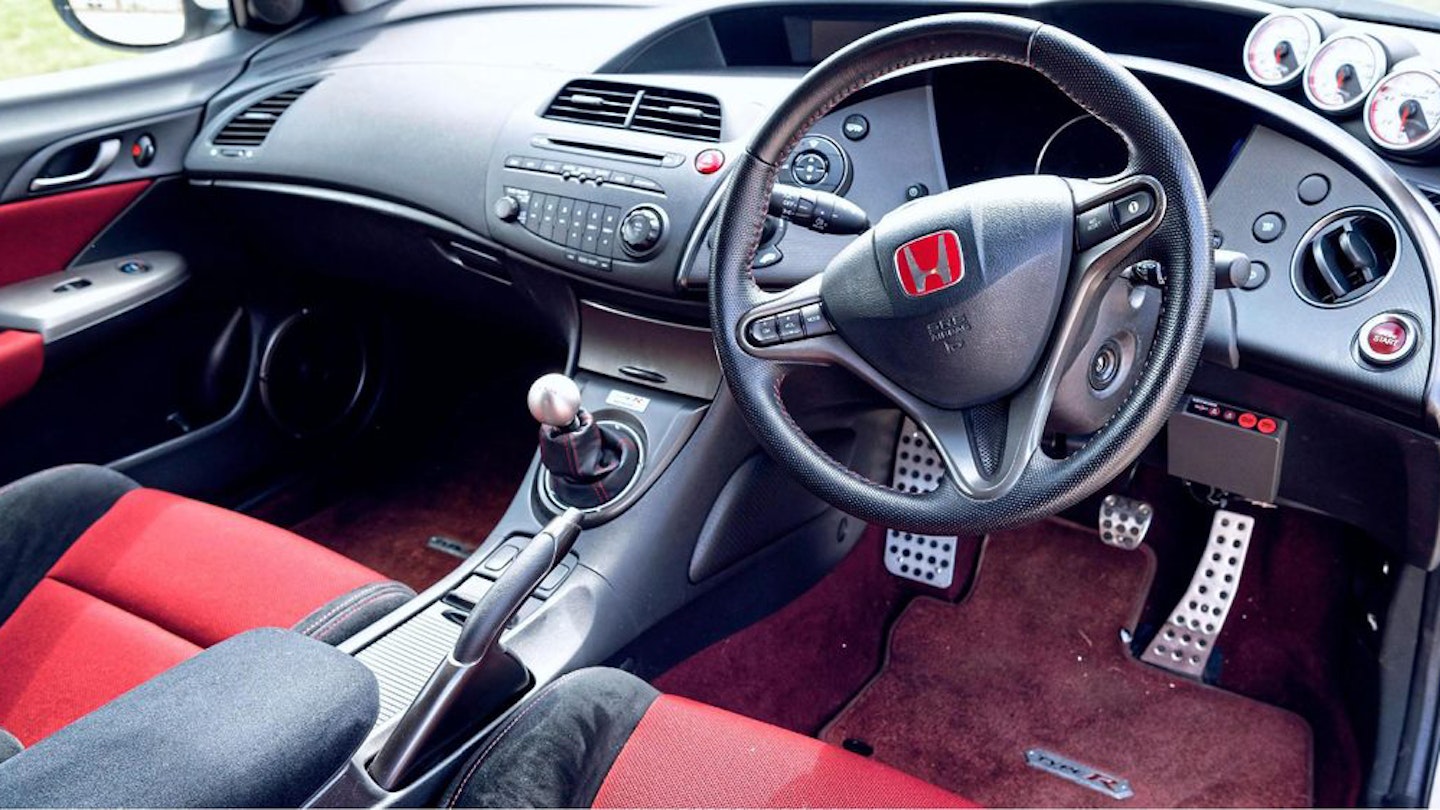
Special centre console badge lists car’s serial number
The only problem is making use of it on the road. Below the screamingly high rpm where the VTEC system kicks in, you have just 140bhp to play with and are liable to be embarrassed by a much more traditional four-cylinder hot hatch. What’s worse, keeping the engine in the 6000-8000rpm happy place means speeds that can result in a potential trip to court.
The short-throw gearshift is smooth and precise – good job, because corners are being dispatched so quickly there’s little time to think about anything other than the rapidly-approaching horizon. I’m no longer driving to the shift lights or rev counter – this glorious engine is wired up directly to my spinal cord.
The FN2-generation Civic Type R arrived in 2007. Based on the eighth generation of Honda’s compact hatchback, the R delivered 198bhp at 7800rpm and 142lb ft of torque and followed previous EK9 and EP3-generation Civic Type Rs. The FN2 was primarily aimed at European and international markets, but was also sold in the car’s home market as the Civic Type R Euro. It wasn’t the mainstay here, though. Designated FD2, this car took the Civic four-door saloon as its basis, the first time the performance model hadn’t appeared as a three-door hatchback.
‘The shrieking turns into a piercing whine as you quickly close in on 8300rpm’
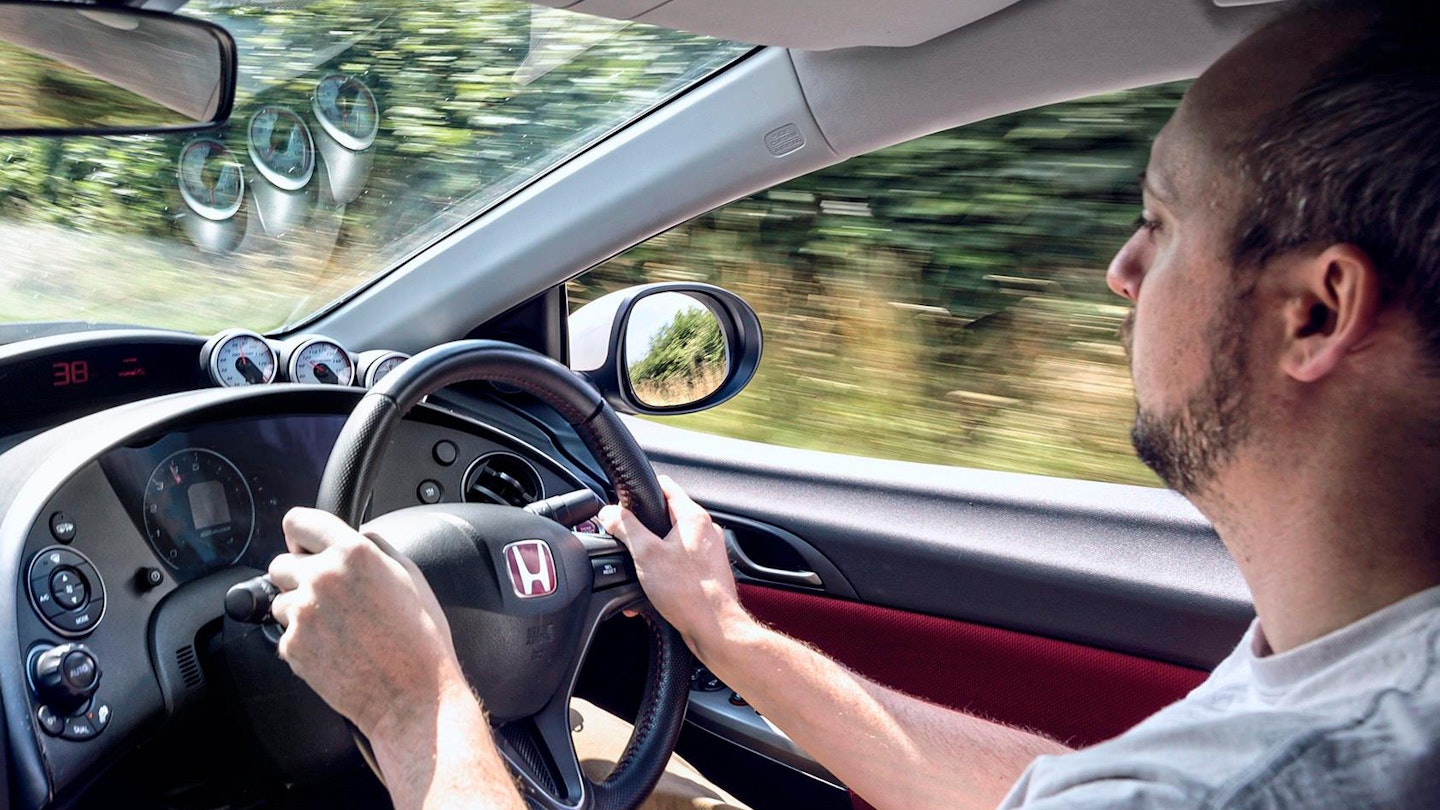
Mugen repeatedly assaults all your senses. Enjoy!
Using the same K20 engine as the FN2, the 222bhp FD2 not only posted more power, but with 159lb ft, more torque, too. A close-ratio six-speed manual gearbox and a helical limited slip differential helped send the power to the front wheels, while at the back, a more sophisticated independent suspension set-up replaced the torsion beam used on the FN2. The FN2 may have been a more focused hot hatchback than most others, but the FD2 raised the Civic’s go-faster game still further.
Whatever the body style, with a reputation for being high-revving and driver-focused machines, all Civic Type Rs enjoy a fiercely devout and dedicated enthusiast following, and perhaps none so more than the Mugen-tweaked models.
‘Mugen’ is the only word you need to whisper if you want to make a Honda obsessive’s eyes glaze over and their significant other worry about meeting next month’s mortgage repayment. Mugen Motorsports has been race-tuning Hondas and selling aftermarket parts since the early Seventies, but while you could tune any bit of your Honda with Mugen parts and accessories, you couldn’t buy an official, and Honda-sanctioned, Mugen car.
‘The Type R Mugen is a breathtaking experience – an 8300rpm banshee’
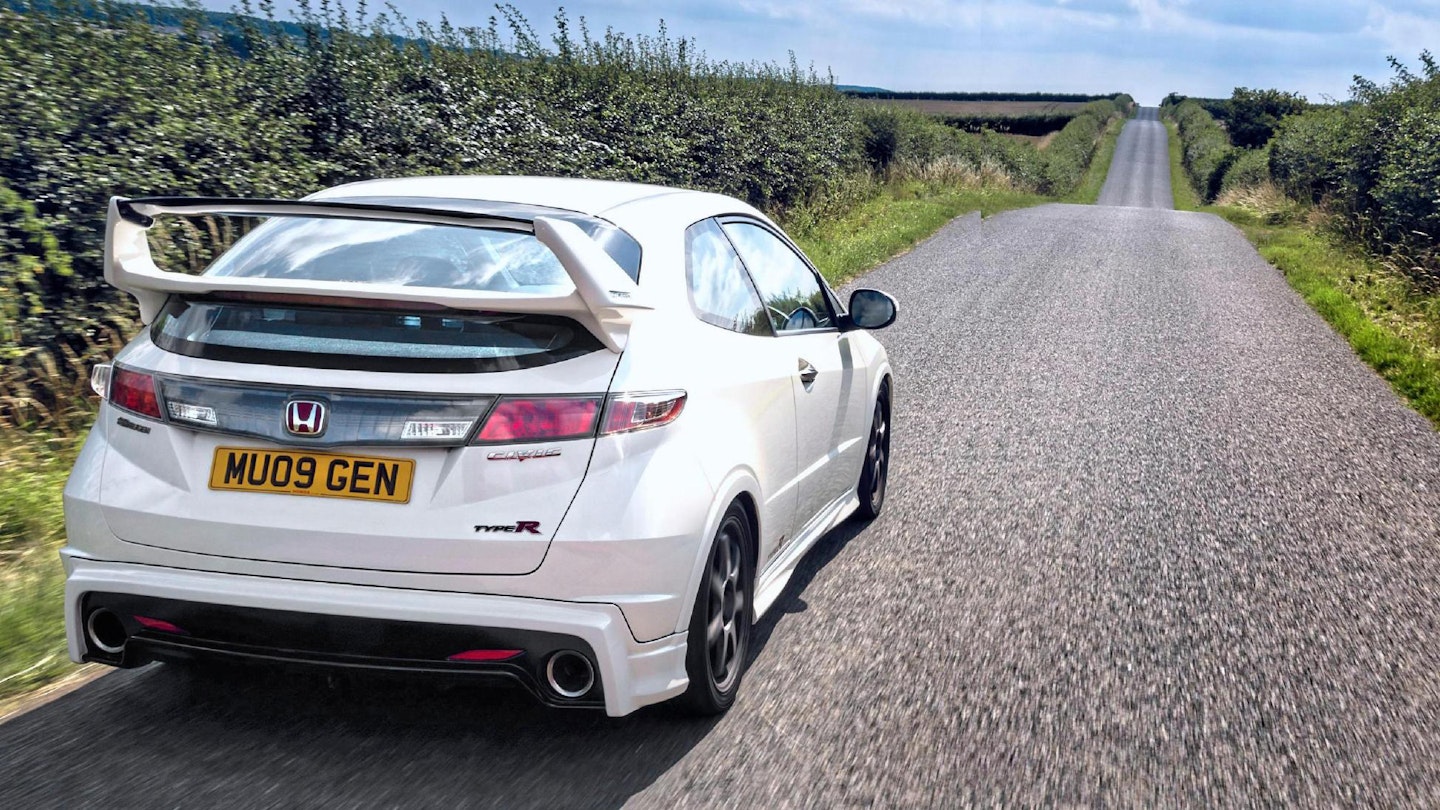
That changed in 2009 when a Mugen Motorsports concept car displayed at the Tokyo Auto Salon showcased just what it could do with the FN2 Civic Type R. The crowd’s response was electric, and Honda aficionados started to get hot under the collar. That heat turned to a fire when Honda announced that a very limited run of 20 examples was to be built by Mugen, solely for the UK.
Compared with the regular Type R, the UK-bound Mugen FN2 featured a revised airbox, intake manifold, pistons, throttle body and valve springs. The stainless-steel exhaust system was bespoke – the centrally-mounted fuel tank of the standard FN2 meant a straight-through exhaust wouldn’t work, but the clever engineers from Northamptonshire have done a sterling job.
The Mugen’s 1233kg weight falls some 34kg below that of the regular Type R. The brakes are lighter than the original car’s, despite all the extra hardware, and the spidery dark-coloured and forged alloy wheels weigh 7.85kg each, a third less than the standard Civic Type R rims. Honda perhaps rightly, called the Type R Mugen a ‘handbuilt race car for the road’.

Forged alloys are just one area of lightweighting
But even to those with a penchant for Hondas, you’d still have to know. Confusingly, there was also a run of Mugen 200 FN2s with a limited-slip front differential and a similar paint scheme, but no engine changes. There are also FN2s that have been modified to look like a Mugen. The waters are muddied further by the factory-produced Championship White Edition – the Type R Mugen’s sole colour choice – cars, based on the top-tier Civic Type R GT trim of the regular model, but with a helical limited-slip differential. And while numbers point to around 500 Championship White Editions being sold, out of that production run of 20 full-spec Mugen Civics, only 16 are believed to have found owners. And the car featured here is the real deal – and arguably the Civic Type R Mugen holy grail – number 00.
In period, it was mooted that the remaining four genuine Mugen Civics were to be converted to 2.2-specification, or the option offered to owners of the other 16 cars. With a Mugenengineered increase of the cylinder bore and stroke to create an overall capacity of 2156cc – with 256bhp and 177lb ft – a single prototype was made, but it’s unclear if more did ever materialise.
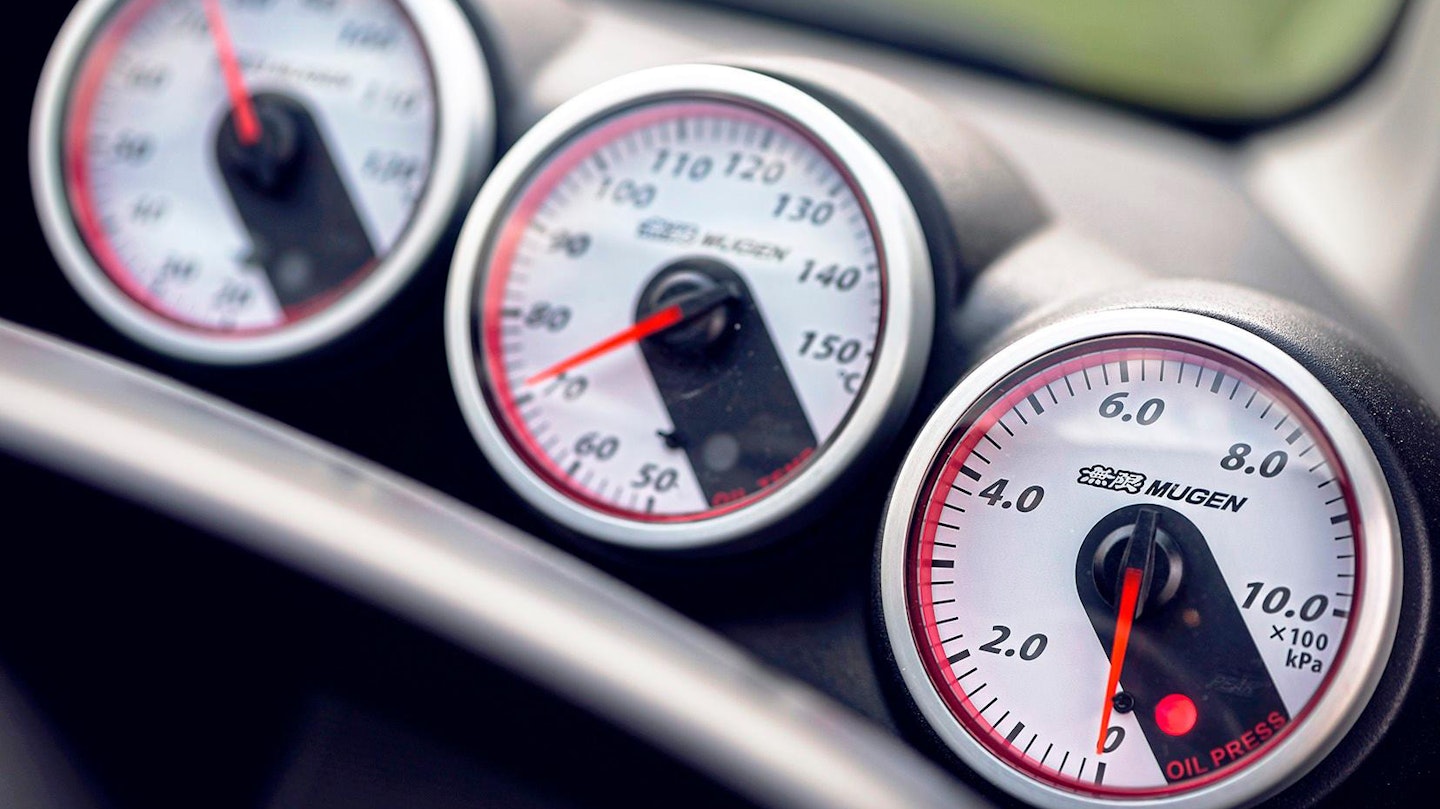
No pressure to perform, but the Mugen really does
The Japanese FD2 also had a Mugen makeover to become the Honda Civic Mugen RR. Notable by only being available in Milano Red, and fitted with carbonfibre bumpers and an aluminium bonnet, power was bumped to 237bhp at 8000rpm by an upgraded ECU, exhaust system and camshafts. Forged wheels, a carbonfibre rear boot spoiler, larger Brembo brakes, and Recaro SP-X seats marked out the limited run of 300 units.
On the move, the UK Mugen is an intensely physical car. Ride comfort is on the firm side of torturous thanks to stifffer springs and dampers than the regular Type R. And the assault on your body doesn’t end there – 20mm larger than standard brakes allied to four-pot monobloc calipers give your sternum the kind of punishment meted out to Private Pyle in Full Metal Jacket.
All of this undoubtedly helps you to richly savour the Mugen experience. The steering is blissfully intuitive and you can feel every inch of road surface that the 18in alloy wheels ride over. The limited-slip differential embeds you onto your line through the corner and the only thing that loses grip are the fleshy bits of your face as cornering forces try their best to drag it all sideways.
‘Every driver who has the merest taste of its upper rev range will want a Civic Type R Mugen’

The excitement begins after 6000rpm
It all makes for a more focused machine, and the Mugen FN2 is a car you can’t help but yearn for. You get out of it after any B-road blast grinning nervously and slightly shaky. Of the many questions you ask yourself, how quickly did I take that corner, and how was that even possible are two that spring to mind.
The Type R Mugen is a rare beast of a kind we’ll never see again. Few will understand its appeal, fewer still will ever own one. But every driver who has the merest taste of its upper rev range will certainly want one. It’s a breathtaking and eye-popping experience. It’s an 8300rpm banshee that only shows its cards in those brief moments when the road is clear. That is both a big part of its appeal and one of its downsides.
The Mugen really needs a racetrack to show its worth – and to prevent points on your licence. But if you were spending a considerable sum of money on a track car, would a Civic really make sense? It was, and still is, very expensive – if you can find one at all. Your starting point for a new one was £38,599. The reasons why it was almost £20,000 more than a regular Civic Type R included direct customer contact with Mugen engineers throughout the build of each individual car, along with a bespoke specification and options package chosen by the new owner, that could even include ECU mapping. The engine itself reportedly took seven days to build.

Mugen means ‘unlimited’ but this Civic scarce
There are so few genuine Mugens that appear for sale, it’s very hard to put a price on one, but you can expect to pay a heavy premium over the £10,000 asked for a 90,000-mile Mugen 200 in presentable condition. But would that cash would be better spent on a fully focused sports car such as a Lotus Elise or a Caterham? Or, if you’re keeping it hot hatchback-only, the Renault Mégane R26R is more focused still.
There is also all manner of aftermarket tuning options that are cheaper. However, while you could buy the Mugen’s brakes, suspension and interior modifications separately, the engine tune-up was bespoke to this limited edition. Specialists on the aftermarket scene could still do a similar job, often preferring forced induction for impressive gains, but focusing on more mid-range torque misses the point of the rev-happy Type R.
The Civic Type R Mugen is a truly special car, and it is a real shame so few were made. This rarity makes it a curio that will theoretically only retain and grow its value, as it’s unlikely we’ll ever see a naturally aspirated and high-revving hot hatchback as focused as this again. Even though this Civic is utterly barmy, impractical and fiscally nonsensical, if you want an example of a very highly focused and unrelenting hot hatch, the Type R Mugen deserves your unwavering respect. Your biggest problem will be finding one.

Road shows focused demeanour; track is the ultimate home
2009 Honda Civic Type R Mugen
Engine 1998cc four-cylinder, dohc, multipoint fuel injection
Power and torque 237bhp @8300rpm; 157lb ft @6250rpm
Transmission Six-speed manual, front-wheel drive, limited-slip differential
Steering Rack-and pinion, power-assisted
Suspension Front: independent, MacPherson struts, Mugen coil springs, gas dampers, anti-roll bar Rear: independent, torsion beam, Mugen coil springs, gas dampers, anti-roll bar
Brakes Discs all round (vented at front), servo-assisted
Performance Top speed: 150mph (limited); 0-62mph 6.0sec
Weight 1233kg (2718lb)
Fuel consumption 21mpg
Cost new £38,599 (2009)
WHAT IS MUGEN?

Formed in 1973 by Hirotoshi Honda (the son of Honda founder Soichiro Honda) and Masao Kimura, Mugen means ‘without limit’. Its first engine was a racing version of the 1200cc Honda Civic unit, which was instantly successful, winning its first race. In 1975 Mugen started selling race parts. Very successful on two wheels and four – even preparing Honda V10 engines for F1 – the company sought to capitalise on its fame, and in the early Eighties began offering tuning and bodywork parts for road cars. In the US, kits were sold through dealers. Mugen continues to compete, primarily in Japanese GT racing, and still sells aftermarket parts for Honda cars. Model highlights include the super-lightweight Mugen NSX concept from 1992 – with more than 320bhp compared with the production car’s 274bhp – and the FD2 Civic Mugen RR.
Subscribe to Classic Cars today. Choose a Print+ Subscription and you'll get instant digital access and so much more. PLUS FREE UK delivery.
